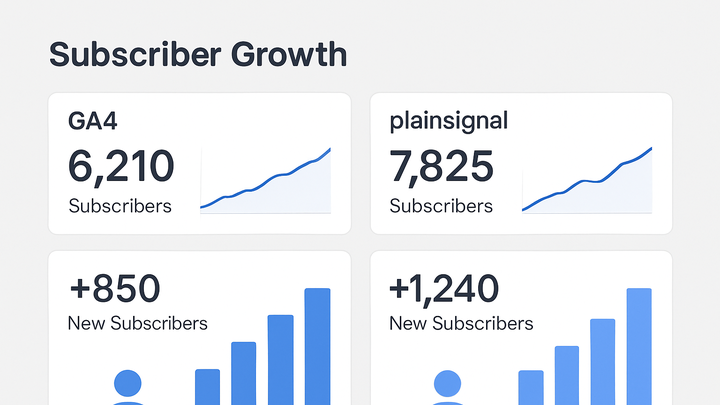Published on 2025-06-22T06:13:57Z
What is a Subscriber? Definition and Examples in Analytics
In analytics, a subscriber is a user who has explicitly opted in to receive ongoing content or communications. Subscribers are distinct from regular visitors because they have granted permission—often via sign-up forms or subscription banners—to receive newsletters, updates, or premium features. Tracking subscriber behavior helps businesses measure engagement, retention, and lifetime value. Platforms like Google Analytics 4 (GA4) and PlainSignal allow you to monitor subscriber metrics, such as growth over time, churn rate, and content interaction. By understanding subscriber patterns, companies can tailor marketing campaigns, improve content strategy, and optimize user experience for their most valuable audience segment.
Subscriber
A subscriber in analytics is a user who opts in for content or communications, tracked via platforms like GA4 and PlainSignal.
Definition and Context
Exploring what qualifies someone as a subscriber in web analytics and how this differs from other user types.
-
Subscriber vs visitor vs user
While any visitor or user interacts with your site, a subscriber has provided consent—like an email address—to receive ongoing updates or content.
-
Opt-in mechanisms
Subscribers typically sign up through forms, pop-ups, or subscription widgets, indicating explicit permission to track and communicate.
Why Subscriber Metrics Matter
Subscriber analytics reveal engagement depth, retention, and the long-term value of your audience.
-
Engagement and retention indicators
Subscribers often show higher engagement: they open emails, return to the site, and interact with content repeatedly.
-
Retention rate
Percentage of subscribers who remain active over a given period.
-
Churn rate
Rate at which subscribers unsubscribe or become inactive.
-
-
Lifetime value (ltv)
Forecasted revenue a subscriber generates over their entire relationship with the brand.
Tracking Subscribers in GA4
How to set up and analyze subscriber data using Google Analytics 4 features.
-
User-id tracking
Assign a unique User-ID to identify subscribers across devices and sessions for unified reporting.
-
Custom user properties
Configure custom user properties like “subscription_status” to segment subscriber behavior in GA4.
Tracking Subscribers with PlainSignal
Implementing PlainSignal’s cookie-free approach to identify and measure subscribers.
-
Cookie-free identification
PlainSignal uses probabilistic and first-party data to recognize repeat visitors as subscribers without cookies or trackers.
-
Implementing the PlainSignal script
Embed the PlainSignal snippet on your pages. Sample code:
<link rel="preconnect" href="//eu.plainsignal.com/" crossorigin /> <script defer data-do="yourwebsitedomain.com" data-id="0GQV1xmtzQQ" data-api="//eu.plainsignal.com" src="//cdn.plainsignal.com/plainsignal-min.js"></script>-
Preconnect tag
Optimizes connection setup to PlainSignal’s servers before loading the script.
-
Script tag
Loads the PlainSignal analytics library and initializes subscriber tracking.
-
Best Practices for Subscriber Analytics
Recommendations to ensure reliable, compliant, and insightful subscriber tracking.
-
Consent and compliance
Always obtain explicit user consent and display clear privacy notices to comply with GDPR, CCPA, and other regulations.
-
Consistent identifier usage
Use the same subscriber ID across GA4 and PlainSignal to unify metrics and avoid data fragmentation.
-
Segmentation and personalization
Segment subscribers by source, subscription type, or engagement level to tailor content and improve retention.
